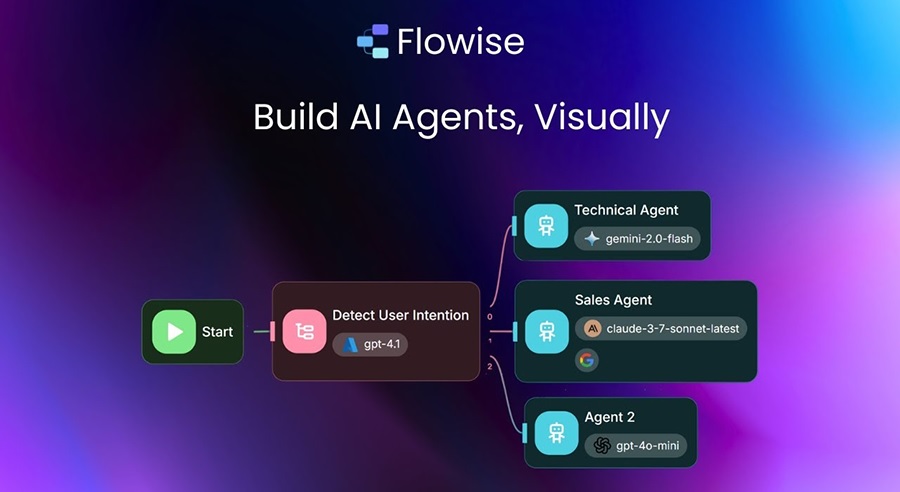
Flowise has quickly gained traction as one of the most flexible platforms for building AI agents and workflows. Its open-source foundation and visual design tools make it appealing to both technical teams and non-technical professionals looking to harness AI. But what really demonstrates its value is how it is being used across industries. From retail to healthcare, companies are leveraging Flowise to streamline operations, improve customer engagement, and create entirely new experiences. This article explores practical use cases of Flowise, showing how organizations are applying it in diverse ways.
Contents
- Retail: Smarter Customer Support and Inventory Management
- Healthcare: Streamlining Patient and Staff Workflows
- Education: Enhancing Learning and Administration
- Finance: Improving Compliance and Client Interactions
- Logistics and Supply Chain: Automating Complex Workflows
- Cross-Industry Use Cases
- Challenges in Real-World Deployments
- Best Practices for Industry Adoption
- The Future of Flowise in Industry
Retail: Smarter Customer Support and Inventory Management
Retailers are under constant pressure to provide excellent customer service while keeping operations lean. Flowise is helping by enabling businesses to build agents that answer questions, manage stock, and support customers in real time.
Customer-facing chatbots
Retailers are deploying Flowise-powered chatbots on their websites to handle common queries such as return policies, shipping times, and product availability. Unlike traditional chatbots with rigid scripts, these agents can pull from up-to-date inventory databases and provide accurate responses. This reduces the load on customer service staff while improving the shopper experience.
Inventory assistants
Behind the scenes, Flowise agents are being integrated with inventory management systems. They monitor stock levels, flag low supplies, and even trigger automatic reorders. These bots help retailers avoid costly stockouts while minimizing excess inventory.
👉 Sign up for a free Flowise AI account
Healthcare: Streamlining Patient and Staff Workflows
The healthcare industry is full of repetitive, document-heavy processes where Flowise excels. Hospitals, clinics, and research institutions are finding ways to use it to cut through complexity without compromising on compliance or patient safety.
Virtual patient assistants
Some providers are building Flowise agents that act as patient-facing assistants. They answer frequently asked questions, schedule appointments, and provide basic health information. By integrating with scheduling systems and medical databases, these assistants reduce administrative workload and improve patient access to care.
Staff support tools
Flowise is also being used internally to assist healthcare staff. For example, agents can quickly retrieve information from electronic health records (EHRs), summarize lengthy clinical documents, or provide step-by-step guides for procedures. These tools save time for nurses and doctors, who can then focus more on patient care.
Education: Enhancing Learning and Administration
In education, Flowise is proving useful both in the classroom and behind the scenes. Schools, universities, and training programs are building AI agents to support students, teachers, and administrators.
Student support bots
Colleges are deploying Flowise bots that answer student queries about course catalogs, exam schedules, and financial aid policies. These assistants reduce wait times for students and free staff from answering repetitive questions.
Research and academic tools
Flowise is also being used in research environments to process academic papers, summarize findings, and manage citations. By connecting agents to document repositories, researchers can query large collections of papers more efficiently.
Finance: Improving Compliance and Client Interactions
In finance, efficiency and accuracy are paramount. Flowise helps institutions automate client interactions, monitor compliance, and streamline workflows that involve large amounts of data.
Client interaction agents
Financial advisors and customer service representatives are using Flowise bots to provide quick responses to client questions about accounts, transactions, or loan applications. These bots can pull real-time data from financial systems, reducing turnaround time for customers.
Compliance monitoring
Financial firms are also building agents that monitor transactions against regulatory frameworks. By integrating with compliance databases, Flowise bots flag potential violations, reducing risk and ensuring smoother audits.
Logistics and Supply Chain: Automating Complex Workflows
Supply chain operations often involve coordinating data and communication across multiple stakeholders. Flowise is proving to be an ideal tool for automating these workflows and keeping everything moving smoothly.
Scheduling and tracking agents
Logistics companies are using Flowise agents to schedule shipments, track packages, and provide updates to customers. By connecting with GPS systems and ERP platforms, these bots reduce manual coordination and keep clients informed.
Inventory and demand forecasting
Beyond tracking, some firms are using Flowise to predict demand and optimize inventory. By analyzing sales data, shipment history, and external signals, agents help organizations prepare for spikes in demand and avoid bottlenecks.
Cross-Industry Use Cases
While each industry has unique needs, some Flowise use cases appear across multiple sectors. These highlight the platform’s flexibility and adaptability.
Knowledge management
Companies in every industry are using Flowise to build internal knowledge assistants. These bots can retrieve policies, summarize long documents, and provide quick answers to employee questions. Whether it’s HR policies in a corporate setting or technical guides in a manufacturing firm, knowledge assistants improve efficiency.
Workflow automation
Another common thread is workflow automation. Businesses use Flowise agents to bridge gaps between existing software systems. For example, a Flowise agent might take input from a CRM, process it through a database, and then trigger a task in a project management platform.
Challenges in Real-World Deployments
Of course, deploying Flowise agents in real companies is not without challenges. Organizations often face issues such as:
- Integration complexity: Connecting multiple legacy systems can take time and technical expertise.
- Security: Safeguarding sensitive data while enabling AI access requires careful planning.
- Scalability: As projects grow, workflows can become harder to manage without strong documentation and modular design.
- Oversight: Human checkpoints remain critical for high-stakes processes to prevent errors or misuse.
Best Practices for Industry Adoption
From lessons learned in real-world projects, some best practices have emerged:
- Start with small pilot projects before scaling.
- Involve end users early to gather feedback and refine workflows.
- Keep workflows modular and reusable for easier maintenance.
- Document integrations and workflows thoroughly for long-term sustainability.
- Ensure oversight for critical decisions, especially in finance and healthcare.
The Future of Flowise in Industry
As adoption grows, Flowise is moving beyond experimental projects into core business functions. Its open-source nature ensures adaptability, and its visual interface lowers barriers for non-technical users. Looking ahead, industries are likely to use Flowise not only for automating existing processes but also for building entirely new services powered by AI agents.
From retail to logistics, Flowise is showing its versatility as a platform for AI-driven workflows. Real companies are using it to improve efficiency, cut costs, and enhance customer experiences. While challenges remain, the benefits are clear: Flowise empowers organizations to design agents that adapt to their unique needs. Whether it’s a small business launching a simple FAQ bot or an enterprise automating complex supply chains, Flowise is proving to be a valuable tool in the AI toolkit.

